


xxxxxAs we have seen, it was in the 1660s that the brilliant English scientist Isaac Newton made three important discoveries: he invented differential calculus, discovered the law of universal gravity, and made important advances in the study of light -
ISAAC NEWTON 1642 -
(C1, CW, C2, J2, W3, AN, G1)
Including:
Gottfried Leibniz

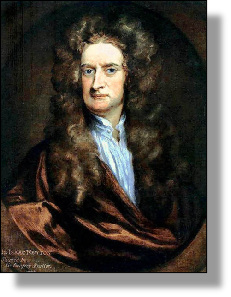 xxxxxAs we have seen (1687 J2), the brilliant English scientist Isaac Newton was born near Grantham, Lincolnshire, and had a troubled childhood, a fact which might well account for his psychosomatic tendencies, shown above all by his fits of rage, his acute sense of insecurity, and his aversion to any hint of criticism. He attended Trinity College, Cambridge in 1661, and was appointed Lucasian professor of mathematics at the university just eight years later.
xxxxxAs we have seen (1687 J2), the brilliant English scientist Isaac Newton was born near Grantham, Lincolnshire, and had a troubled childhood, a fact which might well account for his psychosomatic tendencies, shown above all by his fits of rage, his acute sense of insecurity, and his aversion to any hint of criticism. He attended Trinity College, Cambridge in 1661, and was appointed Lucasian professor of mathematics at the university just eight years later.
xxxxxNot surprisingly, his first major achievement was in the field of mathematics. Having already formulated the binomial theorem, in 1666 he developed what came to be known as “differential calculus”. However, he did not publish his findings and this led to the first of several disputes, on this occasion with the German mathematician Gottfried Leibniz. Having followed the same line of inquiry and come up with similar if not more advanced conclusions, the German made them public in 1684. This infuriated Newton. He claimed to be the sole inventor of this mathematical instrument, and publicly accused Leibniz of deliberate plagiarism in a ferocious quarrel which lasted for well over twenty years. Newton lost no opportunity to vilify his opponent, even after his death.
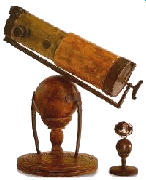 xxxxxIt was in this same year, 1684, that, thanks to the insistence of his friend, the astronomer Edmund Halley, he produced his tract On the Motion of Bodies in Orbit. The ideas he put forward in this work, revised and expanded over the next three years, resulted in his scientific masterpiece the Philosophiae naturalis principia mathematica, universally known as the Principia. Published in 1687 at Halley’s expense, this epoch-
xxxxxIt was in this same year, 1684, that, thanks to the insistence of his friend, the astronomer Edmund Halley, he produced his tract On the Motion of Bodies in Orbit. The ideas he put forward in this work, revised and expanded over the next three years, resulted in his scientific masterpiece the Philosophiae naturalis principia mathematica, universally known as the Principia. Published in 1687 at Halley’s expense, this epoch-
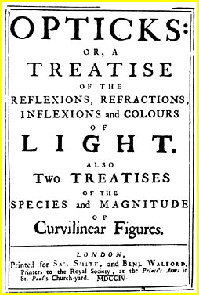 xxxxxIt was as early as the 1660s, in fact, that Newton began his research into the properties of light. Indeed, it was to assist in his experiments with light and prisms that he made his own reflecting telescope in 1668, the first of its kind. But, for the reason explained, it was not until 1704, that he summed up his life’s work on the properties of light in his Opticks, a treatise in which he defended the corpuscular theory of light. He arrived at this theory by means of a series of practical experiments. From these he deduced that sunlight is a heterogeneous mixture of many different types of rays, that these rays are refracted (or bent) at distinct angles, and that each type of ray produces a given colour of the spectrum. Confident in the validity of his findings, in 1672 he sent an outline of his theory to the Royal Society, but when it was published in the society’s Philosophical Transactions, some of its content was questioned, notably by Hooke and the Dutch scientist Christiaan Huygens. This deeply angered Newton and led to a nervous breakdown. He eventually carried on with his research but, fearful as ever of criticism, and angered by Hooke’s haughty rebuff, it was over 30 years before his pioneer work on the nature of light was published.
xxxxxIt was as early as the 1660s, in fact, that Newton began his research into the properties of light. Indeed, it was to assist in his experiments with light and prisms that he made his own reflecting telescope in 1668, the first of its kind. But, for the reason explained, it was not until 1704, that he summed up his life’s work on the properties of light in his Opticks, a treatise in which he defended the corpuscular theory of light. He arrived at this theory by means of a series of practical experiments. From these he deduced that sunlight is a heterogeneous mixture of many different types of rays, that these rays are refracted (or bent) at distinct angles, and that each type of ray produces a given colour of the spectrum. Confident in the validity of his findings, in 1672 he sent an outline of his theory to the Royal Society, but when it was published in the society’s Philosophical Transactions, some of its content was questioned, notably by Hooke and the Dutch scientist Christiaan Huygens. This deeply angered Newton and led to a nervous breakdown. He eventually carried on with his research but, fearful as ever of criticism, and angered by Hooke’s haughty rebuff, it was over 30 years before his pioneer work on the nature of light was published.
xxxxxBy the turn of the century Newton was an important and highly respected public figure. He was the Member of Parliament for Cambridge University for a number of years, and master of the Royal Mint in London -
xxxxxBut despite his honourable status, he was quite capable of dishonourable behaviour. It was at this time that he became involved in yet another bitter controversy, and one which earned him no credit. Anxious to advance his lunar theory, he conspired with his close friend Edmund Halley to obtain the data he needed from the astronomical observations made and held by John Flamsteed, the Astronomer Royal. Flamsteed, who had earlier helped Newton with his Principia, wished to keep these findings unpublished until his work was completed, but Newton, taking advantage of his position as President of the Royal Society, forced Flamsteed to hand over his observations. In 1712 Halley edited them and had them published. Before they were circulated, however, Flamsteed managed to retrieve and destroy all but a hundred of the printed copies. To add insult to injury, when Newton later revised his Principia he removed any references to Flamsteed’s help with the first edition!
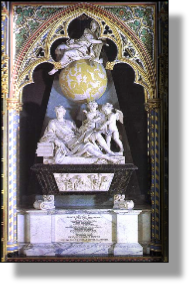 xxxxxIt was in 1696, following a further period of mental ill-
xxxxxIt was in 1696, following a further period of mental ill-
xxxxxBut the unfortunate controversies that punctuated Newton’s long career can in no way detract from his staggering achievements across so wide a field of human endeavour, be it in astronomy, mathematics, mechanics, optics or planetary motion. A man of genius, he stands alongside Galileo and Einstein as one of the three greatest scientific explorers of the universe. The English poet Alexander Pope summed up his accomplishments:
Nature and nature’s laws lay hid in night;
God said, “Let Newton be!” and all was light.
xxxxxAnd later the English poet William Wordsworth spoke of Newton voyaging through “strange seas of thought, alone”.
Towards the end of his life Newton wrote:
xxxxxIf I have seen further, it is by standing on the shoulders of giants .... I do not know what I may appear to the world, but to myself I seem to have been like a boy playing on the seashore and diverting myself in now and then finding a smoother pebble or a prettier shell than ordinary, whilst the great ocean of truth lay all undiscovered before me. Some boy!
xxxxxThe German scientist Gottfried Leibniz (1646-
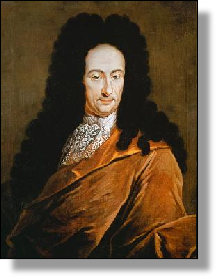 xxxxxGottfried Leibniz (1646-
xxxxxGottfried Leibniz (1646-
xxxxxHis major work, The Monadology, published in 1714, set out to explain the nature of the world by a highly imaginative and optimistic theory. Based on the idea of a single underlying principle, this proposed that the world was made up of an infinite number of units which he called "monads". These centres of spiritual energy, each with individual properties, determined the past, present and future. The first monad had been God, and he had made all the remaining monads at the time of creation. As these units were indestructible, and as God was all-
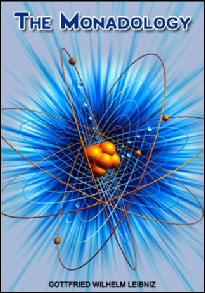 xxxxxIt was over the years 1673 to 1676 that Leibniz discovered the calculus, encouraged by the teaching of the Dutch mathematician Christiaan Huygens. He went on to publish his account of differential calculus in 1684 and that of integral calculus two years later. Newton, in fact, had made virtually the same discovery a decade earlier -
xxxxxIt was over the years 1673 to 1676 that Leibniz discovered the calculus, encouraged by the teaching of the Dutch mathematician Christiaan Huygens. He went on to publish his account of differential calculus in 1684 and that of integral calculus two years later. Newton, in fact, had made virtually the same discovery a decade earlier -
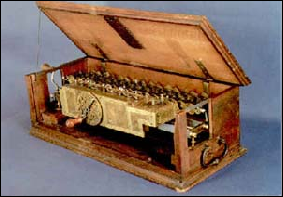 xxxxxA man of incredibly wide interest and knowledge, he also wrote on theology, law, history, diplomacy and physics. He tried his hand at designing a number of mechanical devices, including a lamp, clock and a water pump, and in 1673 succeeded in constructing a calculating machine (illustrated) which, incorporating a crude method of multiplication, was an advance upon the earlier model made by the French scientist Blaise Pascal in 1642. He at one time put forward the idea of building a canal through the Isthmus of Suez, and over many years he put his mind to devising what he called his Universal Characteristic, a logical language which could be understood by everyone. But outside of his work in philosophy and mathematics, perhaps his greatest contribution was in the field of education. He met Peter the Great on a number of occasions to advise him on educational reforms in Russia, and he was instrumental in founding science academies in both St. Petersburg and Berlin.
xxxxxA man of incredibly wide interest and knowledge, he also wrote on theology, law, history, diplomacy and physics. He tried his hand at designing a number of mechanical devices, including a lamp, clock and a water pump, and in 1673 succeeded in constructing a calculating machine (illustrated) which, incorporating a crude method of multiplication, was an advance upon the earlier model made by the French scientist Blaise Pascal in 1642. He at one time put forward the idea of building a canal through the Isthmus of Suez, and over many years he put his mind to devising what he called his Universal Characteristic, a logical language which could be understood by everyone. But outside of his work in philosophy and mathematics, perhaps his greatest contribution was in the field of education. He met Peter the Great on a number of occasions to advise him on educational reforms in Russia, and he was instrumental in founding science academies in both St. Petersburg and Berlin.
xxxxxIncidentally, Leibniz’s apparent view of life, seen as far too optimistic in his Monadology -
Acknowledgements
Newton: by the German/British portrait painter Sir Godfrey Kneller (1646-
AN-


